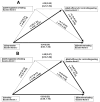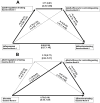Depression and Anxiety Changes Associated with Matched Increases in Physical Activity in Education-, Self-Regulation-, and Self-Regulation Plus Relaxation-Based Obesity Treatments in Women: A Pilot Study Investigating Implications for Controlling Emotional Eating
- PMID: 40806060
- PMCID: PMC12348095
- DOI: 10.3390/nu17152475
Depression and Anxiety Changes Associated with Matched Increases in Physical Activity in Education-, Self-Regulation-, and Self-Regulation Plus Relaxation-Based Obesity Treatments in Women: A Pilot Study Investigating Implications for Controlling Emotional Eating
Abstract
Background/Objectives: Improvements in depression and anxiety, associated with moderate increases in physical activity, might induce reductions in emotional eating, especially in women with obesity, where emotion-driven eating is highly problematic. This pilot, field-based study sought to assess whether physical activity increase, itself, primarily predicts improved mood (biochemical theories) or if psychosocial factors associated with cognitive-behavioral treatment are principal correlates (behavioral theories). An aim was to inform improved treatment processes. Methods: Women with obesity participated in 6-month community-based behavioral obesity treatments emphasizing either: (a) standard education in weight-reduction methods (n = 28), (b) eating-related self-regulation methods (n = 24), or (c) self-regulation + relaxation training (n = 24). They completed a series of behavioral and psychological self-reports at baseline and Months 3 and 6. Results: Findings confirmed no significant difference in 3-month increases in physical activity, by group. There were significantly greater overall improvements in depression, emotional eating, self-regulation, and self-efficacy across the two self-regulation-focused groups (ps < 0.02), with anxiety improvement not reaching significance (p = 0.055). Separate significant paths from 3-month changes in depression and anxiety → self-efficacy change → emotional eating change were found. The same significant path was detected emanating from 6-month anxiety change; however, the hypothesized path of 6-month changes in depression → self-regulation → self-efficacy → emotional eating was, rather, significant. Weight reduction was considerably greater in the two self-regulation-based groups (~6% reduction), with simultaneously entered changes in self-regulation and self-efficacy significant predictors of those weight changes. Conclusions: Findings suggested viability in behavioral theory-driven explanations of the physical activity-mood improvement relationship. Future treatment foci on self-regulatory skills development leading to improvements in eating-related self-efficacy, emotional eating, and weight were suggested to extend the findings of this pilot study.
Keywords: anxiety; depression; emotional eating; obesity; physical activity; self-efficacy; self-regulation; treatment.
Conflict of interest statement
J.J.A. was employed by Mind Body Wellbeing, LLC. The remaining authors declare that the research was conducted in the absence of any commercial or financial relationships that could be construed as a potential conflict of interest.
Figures


Similar articles
-
Reduction of High Emotional Eating via Increased Physical Activity: Assessing a Path Informed by Multiple Behavioral Theories Within Community-Based Obesity Interventions.J Prev (2022). 2025 Aug;46(4):487-509. doi: 10.1007/s10935-025-00842-1. Epub 2025 Apr 17. J Prev (2022). 2025. PMID: 40246792
-
Prescription of Controlled Substances: Benefits and Risks.2025 Jul 6. In: StatPearls [Internet]. Treasure Island (FL): StatPearls Publishing; 2025 Jan–. 2025 Jul 6. In: StatPearls [Internet]. Treasure Island (FL): StatPearls Publishing; 2025 Jan–. PMID: 30726003 Free Books & Documents.
-
Psychosocial Predictors of Maintained Weight Loss in Women: Informing Behavioral Obesity Treatment Foci.Int J Behav Med. 2025 Aug;32(4):541-549. doi: 10.1007/s12529-024-10294-2. Epub 2024 May 15. Int J Behav Med. 2025. PMID: 38750316
-
Psychological therapies for women who experience intimate partner violence.Cochrane Database Syst Rev. 2020 Jul 1;7(7):CD013017. doi: 10.1002/14651858.CD013017.pub2. Cochrane Database Syst Rev. 2020. PMID: 32608505 Free PMC article.
-
Specialist breast care nurses for support of women with breast cancer.Cochrane Database Syst Rev. 2021 Feb 3;2(2):CD005634. doi: 10.1002/14651858.CD005634.pub3. Cochrane Database Syst Rev. 2021. PMID: 34559420 Free PMC article.
References
-
- Dakanalis A., Mentzelou M., Papadopoulou S.K., Papandreou D., Spanoudaki M., Vasios G.K., Pavlidou E., Mantzorou M., Giaginis C. The association of emotional eating with overweight/obesity, depression, anxiety/stress, and dietary patterns: A review of the current clinical evidence. Nutrients. 2023;15:1173. doi: 10.3390/nu15051173. - DOI - PMC - PubMed
MeSH terms
LinkOut - more resources
Full Text Sources

